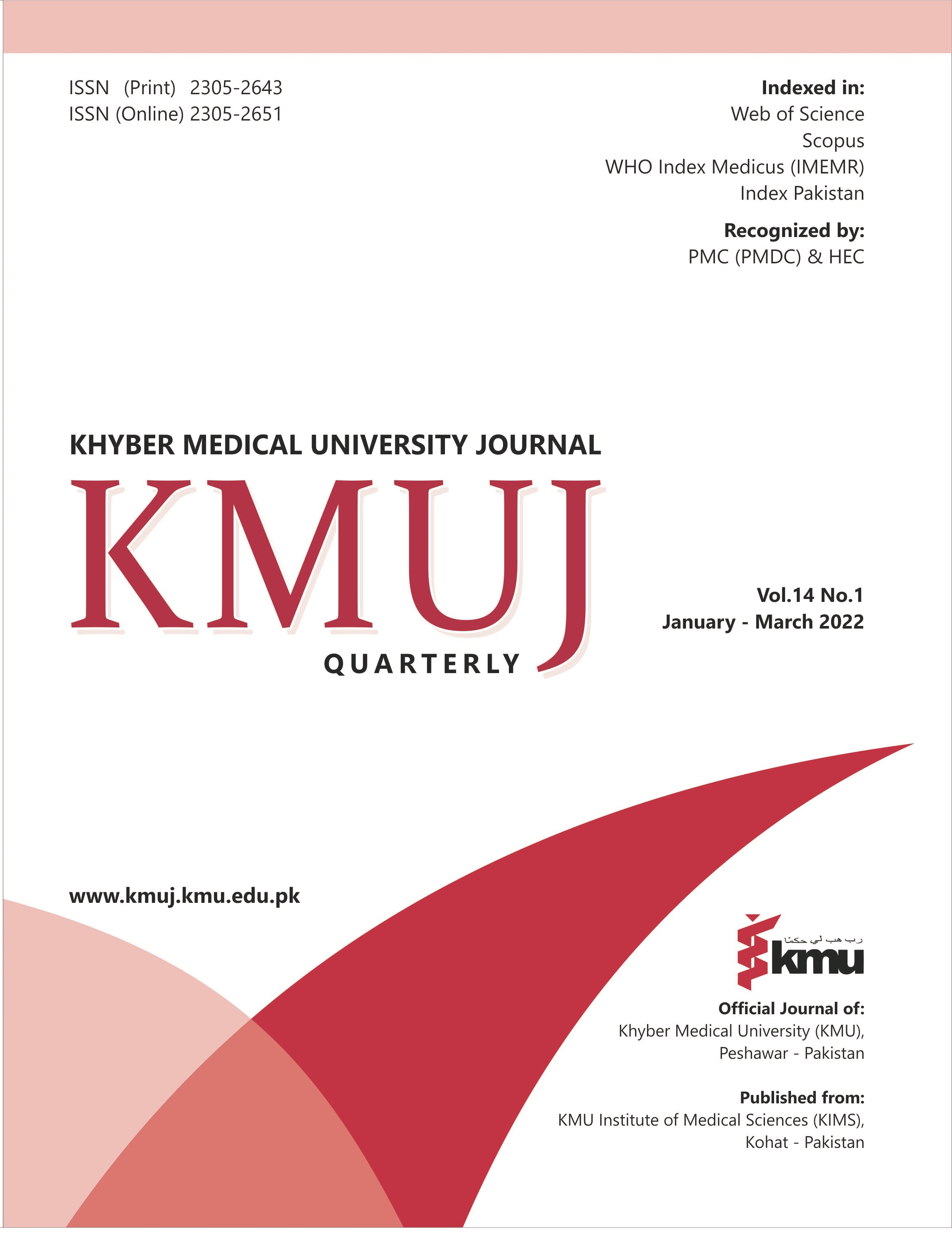COMPARATIVE STUDY OF THE FLEXURAL STRENGTH OF MAXILLARY DENTURE BASES MADE IN CONVENTIONAL AND HIGH IMPACT HEAT CURE ACRYLIC RESIN
Main Article Content
Abstract
OBJECTIVE: To compare the flexural strength of maxillary denture bases made in high impact and conventional heat cure acrylic resin.
METHODS: This experimental laboratory-based study was conducted in Peshawar Dental College, Materials Research and Centralized Resource Laboratories University of Peshawar, Pakistan. Total 120 edentulous maxillary casts, sixty each of conventional acrylic (30 in subgroup-IA for shallow palate and 30 in subgroup-IB for deep palate and high impact acrylic (30 in subgroup II-A for shallow palate and 30 in subgroup II-B for deep palate) were made. These were then tested for flexural strength using universal testing machine. The load was applied at the rate of 5.0 mm/min. Independent samples t-test was applied for statistical analysis.
RESULTS: Mean values of deflection at fracture, fracture load and flexure strength were 0.309±0.059 cm, 87.729±22.497 Kg and 13.645± 4.453 kg/cm² respectively. Mean Flexure Strength (kg/cm2) was 8.30±1.27, 16.54±1.77, 10.88±1.01 and 18.85±1 in subgroups I-A, I-B, II-A and II-B respectively (<0.001). Mean deflection at fracture (cm) was 0.24±0.04, 0.29±0.03, 0.35±0.03 & 0.368±0.03 in subgroups I-A, I-B, II-A and II-B respectively (<0.001).Mean Fracture Load (Kg) was 69.97±3.12, 114.9±6.75, 63.28±7.05 & 102.8±5.5 in in subgroups I-A, I-B, II-A and II-B respectively (<0.001).
CONCLUSION: High impact acrylic resin was found to have significantly higher flexure strength as compared to conventional acrylic resin
Article Details
Work published in KMUJ is licensed under a
Creative Commons Attribution 4.0 License
Authors are permitted and encouraged to post their work online (e.g., in institutional repositories or on their website) prior to and during the submission process, as it can lead to productive exchanges, as well as earlier and greater citation of published work.
(e.g., in institutional repositories or on their website) prior to and during the submission process, as it can lead to productive exchanges, as well as earlier and greater citation of published work.
References
Ghani F, Kikuchi M, Lynch CD, Watanabe M. Effect of some curing methods on acrylic maxillary denture base fit. Eur J Prosthodont Restor Dent 2010;18(3):132- 8.
Pick B, Meira JB, Driemeier L, Braga R. A critical view on biaxial and short-beam uniaxial flexural strength tests applied to resin composites using Weibull, fractographic and finite element analyses. Dent Mater 2010;26(1):83-90. https://doi.org/10.1016/j.dental.2009.09.002
Dhiman R, Chowdhury SR. Midline fractures in single maxillary complete acrylic vs flexible dentures. Med J Armed Forces India 2009; 65(2): 141-5. https://doi.org/10.1016/s0377-1237(09)80128-7
Ucar Y, Akova T & Aysan I. Mechanical properties of polyamide versus different PMMA denture base materials. J Prosthodont 2012;21(3):173-6. https://doi.org/10.1111/j.1532-849x.2011.00804.x
Sowmya S, Dhakshaini MR, Gujjari AK, Ravi MB, Raghavendra Swamy KN. Palatal vault depth influence on the flexural strength of two heat cure acrylic denture base resins-an in vitro comparative study. World Appl Sci J 2013;21(9):1290-4. https://doi.org/10.5829/idosi.wasj.2013.21.9.9
Morris JC, Khan Z, Von Fraunhofer JA. Palatal shape and the flexural strength of maxillary denture bases. J Prosthet Dent 1985;53(5):670-3. https://doi.org/10.1016/0022-3913(85)90018-6
Nisar S, Moeen F & Hasan U. Effect of varying curing regimes and powder-liquid ratios on the flexural strength and surface porosities of heat cure acrylic: an in-vitro experiment. Int J Dent Sci Res 2015;3(3):64-71. http://doi.org/10.12691/ijdsr-3-3-6
Vallittu PK, Sevelius C. Resin-bonded, glass fiber-reinforced composite fixed partial dentures: a clinical study. J Prosthet Dent 2000;84(4):413-418. https://doi.org/10.1067/mpr.2000.109782
Vallittu PK, Vojtkova H, Lassila VP. Impact strength of denture polymethyl methacrylate reinforced with continuous glass fibers or metal wire. Acta Odontol Scand 1995;53(6), 392-396. https://doi.org/10.3109/00016359509006007
Triveni VVS, Sujai GVNS, Bharath S, Guruprasad G. An incidence based assessment of etiology and position of fracture of acrylic resin dentures: a survey based original study. J Adv Med Dent Scie Res 2019;7(11):95-9.
Ray PK, Makhal M, Sen SK. Incidence and causes of fracture of acrylic resin complete denture. J Evol Med Dent Sci 2014;3(69):14787-93. https://doi.org/10.14260/JEMDS%2F2014%2F3986
Choi M, Acharya V, Berg RW, Marotta J, Green CC, Barbizam JV et al. Resinous denture base fracture resistance: effects of thickness and teeth. Int J Prosthodont 2012;25(1):53-9.
Hout D, Wonglamsam A, Kanchanavasita W. Flexural strength of relined denture base using different thickness of self-cured relining material. M Dent J 2017;37(2):223-32.
Reddy BMM, Himabindu M , Padmaja BI, Sunil M, Reddy NR. Palatal vault depth influence on the flexural strength of two heat cure acrylic denture base resins: an in vitro study. J Contemp Dent Pract 2013;14(6):1131-6. https://doi.org/10.5005/jp-journals-10024-1463
Ajaj-ALKordy NM, Alsaadi MH. Elastic modulus and flexural strength comparisons of high-impact and traditional denture base acrylic resins. Saudi Dent J 2014;26(1):15-8. https://doi.org/10.1016/j.sdentj.2013.12.005
Ajay R, Suma K, Ali SA. Monomer modifications of denture base acrylic resin: A systematic review and meta-analysis. J Pharm Bioallied Sci 2019;11(Suppl 2):S112-25. https://doi.org/10.4103/jpbs.jpbs_34_19
Nandal S, Ghalaut P, Shekhawat H, Gulati MS. New era in denture base resins: a review. Dent J Adv Stud 2013;1(03):136-43. https://doi.org/10.1055/S-0038-1671969
